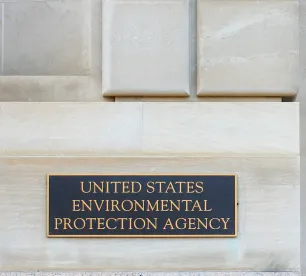On December 29, the chemicals program at EPA closed out 2021 by proposing revisions to its risk determinations for the Cyclic Aliphatic Bromide Cluster (HBCD), a solvent used as a flame retardant and wetting agent which has not been manufactured in the United States in nearly five years. In doing so, the Biden EPA made good on its June 2021 promise to revisit risk determinations previously made during the Trump Administration in accordance with the Toxic Substances Control Act (TSCA). The draft “revisions” represent a significant shift from EPA’s prior approach to existing chemical risk evaluation and foreshadow increased regulatory and litigation risk for all companies—not just those whose operations may have historically involved HBCD.
Specifically, while EPA did not conduct any new analysis for HBCD, EPA states that it revised the risk determinations based on a new “whole chemical” approach. This is a significant policy change EPA publicly announced in a June 30, 2021 press release, arguing that the approach ensures that “the public is protected from unreasonable risks from chemicals in a way that is supported by the science and the law.” In short, under the “whole chemical” approach, EPA will decide whether a chemical, at the broadest (and arguably most abstract) level, poses an “unreasonable risk” to human health or the environment. This abandons the previous approach, under which EPA would consider a chemical’s risk according to each “condition of use”—or, in layman’s terms, the individual ways a specific chemical is used.
To illustrate the differences in the two approaches, consider a hypothetical chemical, “Chemical XYZ.” EPA reviews available data and determines that Chemical XYZ is used in 100 different ways by industry and consumers. EPA then analyzes the first 45 ways Chemical XYZ is used and finds that those 45 uses are safe and do not pose any unreasonable risk to human health or the environment. But when it reviews the other 55 uses, EPA determines that that these particular uses do pose an “unreasonable risk.” Under the prior approach, EPA would make a specific determination that “Conditions of Use #46-100 of Chemical XYZ pose an unreasonable risk,” allowing EPA to focus its resources on uses with the greatest potential risk. Under the new approach, however, because some conditions of use pose an unreasonable risk, EPA’s determination would be that “Chemical XYZ poses an unreasonable risk,” without limiting the determination to only those Conditions of Use where there was an unreasonable risk. This new approach also begs the question of whether EPA will issue any “no unreasonable risk” determinations going forward, particularly since the high-priority substances selected for risk evaluation are those that EPA has already determined “may present an unreasonable risk” during the prioritization process.
This is not just an issue of semantics. In a previous blog post, we discussed whether this approach makes sense from a public health perspective. We questioned this because the whole chemical approach makes irrelevant any specific exposure conditions associated with the use of a chemical. Thus, the “risk” finding really becomes a hazard-based label. And this is a meaningful difference: scientifically, a hazard is simply the abstract possibility that something could cause harm. Risk, on the other hand, is the real-world likelihood of harm actually occurring given exposure to the hazard. If EPA conflates “hazards” with real-world “risks,” it may actually weaken its overall goal to protect health and the environment. It is well documented in scientific literature that over-warning can cause consumers to actually ignore warnings. In other words, if “unreasonable risk” labels are ubiquitous, consumers may begin to ignore labels and warnings. This phenomenon is often discussed in the context of California’s Prop 65 warnings, which are so commonplace that many consumers do not read them at all, let alone make the decision not to use a product because of the warning.
And this proposed approach has consequences for litigation, too—EPA’s “whole chemical” risk determinations may very well give plaintiffs’ lawyers new ammunition by enabling them to (correctly) claim that EPA determined that a chemical posed an unreasonable risk to human health, even if EPA determined that the specific condition of use the plaintiff experienced posed no risk. Juries typically afford significant weight to regulatory determinations, especially from the federal government, and an overly broad regulatory finding could cloud the issues and effectively force defendants to disprove a risk, turning the burden of proof on its head.
In an interesting twist, EPA does apparently intend to consider the specific exposure scenarios in the risk management rules that are planned for HBCD. Thus, the exposure information will still be used, and the resulting risk management rules should (in theory) be tailored only to those conditions of use that do actually pose an unreasonable risk to human health and the environment. But, ultimately, HBCD will still be tagged with the “unreasonable risk” determination overall. And HBCD is only the first of what we expect to be many common chemicals that will soon go on EPA’s “unreasonable risk” list. EPA intends to apply the new whole chemical approach to other chemicals that were evaluated as part of the first 10 risk evaluations under TSCA as well as for future risk evaluations. Those labels will follow these chemicals—and the companies who utilize them, even if, and when, they are safely used.
Aside from the public health and practical implications of EPA’s proposed approach, there are also significant questions about whether it has any legal or statutory basis. EPA justified its policy change in a Federal Register Notice, stating “that a whole chemical approach better aligns with TSCA’s objective of protecting health and the environment.” There is no doubt that that is EPA’s overall role. But TSCA—the statute which gives EPA the authority to conduct these risk evaluations in the first place—does not have a set of clearly stated objectives. More importantly, in 2016 when the Lautenberg Amendments updated TSCA, Congress re-affirmed the importance of TSCA as a risk-based statute. The application of these new labels, on a whole chemical, without a specific exposure context, could be interpreted as inconsistent with a risk-based approach. Further, EPA’s regulation at 40 C.F.R. § 702.47 clearly states that unreasonable risk determinations in risk evaluations will be based on “each condition of uses [sic] within the scope of the risk evaluation” (emphasis added). EPA is reportedly working to revise this regulation, but it is not clear whether EPA can legally finalize its revisions unless and until the regulation is modified.
Whether EPA’s new approach will be challenged remains to be seen. Two years ago, a coalition of consumer groups sued EPA over the risk evaluation process and challenged the then-Trump EPA’s prior, use-by-use approach. The Ninth Circuit Court of Appeals held that the group’s challenge was premature because, at the time, EPA had not yet made any risk determinations at all. Now that it has made risk determinations—and is proposing about-face in making them—it may be industry’s turn to challenge EPA’s approach. In the meantime, companies should keep a close eye on EPA’s activities in 2022 as it gears up to “revise” other previous risk determinations and begins to issue its first proposed risk management rules under its new approach. Comments on this proposed approach and the revised risk determinations for HBCD are due to EPA on February 14.







 />i
/>i

